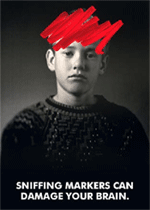
New research shows that young people who have been treated for mental health problems, have a history of foster care, or who already abuse other drugs have an increased risk of abusing or becoming dependent on inhalants. In addition, adolescents who first begin using inhalants at an early age are more likely to become dependent on them . The study by Dr. Li-Tzy Wu and her colleagues is published in the October 2004 issue of the Journal of the American Academy of Child and Adolescent Psychiatry. The study was funded by the National Institute on Drug Abuse (NIDA), National Institutes of Health (NIH), Department of Health and Human Services.
The most commonly used inhalants reported by participants were glue, shoe polish, and gasoline. Other inhalants used by the participants included nitrous oxide, lighter fluid, spray paints, correction fluid, and paint solvents. Boys were more likely to have ever used gasoline or nitrous oxide, while girls favored glue, shoe polish, spray paints, correction fluid, and aerosol sprays.
"These findings suggest inhalant abuse and addiction in young people are associated with a host of co-occurring problems that may be influenced by family and other social factors," says NIDA Director Dr. Nora D. Volkow. "And, inhalant abuse may be escalating. Data reported in NIDA's Monitoring the Future (MTF) Survey show that past-year use of inhalants rose 14 percent from 2002 to 2003--the only increase of any substance reported by MTF between 2002 and 2003."

Dr. Wu and colleagues examined the prevalence and characteristics of inhalant use, abuse, and dependence among 36,859 adolescents aged 12-17 who participated in the 2000 and 2001 National Household Surveys on Drug Abuse (recently renamed the National Survey on Drug Use & Health) by the Substance Abuse and Mental Health Services Administration. Approximately 9 percent of the survey participants--representing nearly 2 million adolescents nationwide--reported having ever used inhalants in their lifetime. Among adolescents who reported using inhalants during the past year, 11 percent met the diagnostic criteria for abuse or dependence. There were no gender differences in the prevalence of inhalant abuse or dependence.
Analysis of the accumulated data showed that:
- Adolescents who reported first use of inhalants at age 13-14 were six times more likely to be dependent on inhalants than those who started using inhalants at age 15-17;
- Adolescents with a history of foster care placement were about five times more likely to become dependent on inhalants than those never placed away from home;
- Adolescents who were treated for mental health problems were more than two times as likely to be dependent on inhalants;
- Adolescents who abused or were dependent on two other drugs (such as cocaine/crack, marijuana/hashish, heroin, hallucinogens, sedatives, tranquilizers, pain relievers, and stimulants) also were likely to use inhalants; they were about four times more likely to be diagnosed with inhalant abuse and about nine times more likely to be diagnosed with inhalant dependence.
"Our study provides more evidence that early use of inhalants may be a precursor for later drug abuse that grows to include abuse of multiple illegal substances," says Dr. Wu. "We found that approximately 60 percent of the adolescents who reported using inhalants during the past year also reporting the use of more than one type of inhalant."
Adds Dr. Volkow: "Children and adolescents who abuse inhalants are at substantial risk of illness and death so it is important for prevention programs to target children when they are young. In addiction, factors such as early inhalant use, foster care placement, and coexisting mental illnesses may help identify young people who are especially vulnerable to severe drug abuse and mental health problems."
